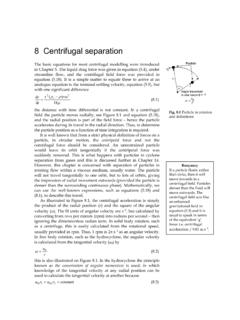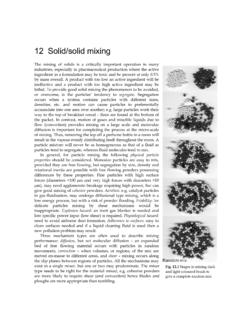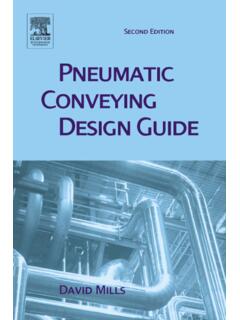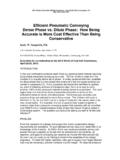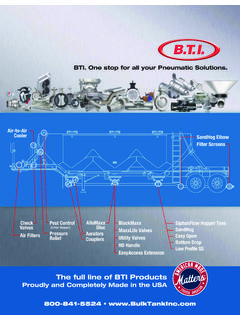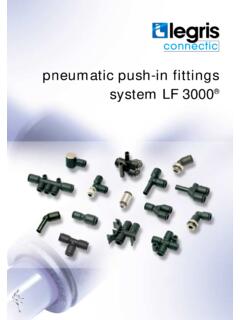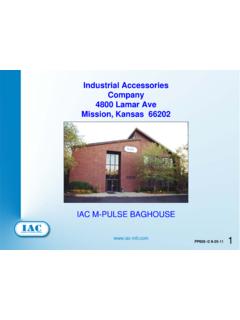Transcription of 9 Conveying - particles.org.uk
1 9 conveying This chapter covers the transportation of particles by fluids. It considers hydraulic, pneumatic and mechanical Conveying means. The former uses liquids the second gases and an example of the latter is a conveyer belt. A basic course in fluid mechanics will equip the reader with sufficient knowledge to calculate the pressure drop for a given flow rate of a uniform, or homogeneous, fluid. When considering particles suspended in flow, however, it is possible for the particle to slip in the fluid; the fluid travels faster than the solid particle. It is also possible for two distinct regions to be visible: a dilute, or emulsion, region with few particles and a dense region below it. This is illustrated in Figure In the case of homogeneous flow, where there is no slip and the particles merely add to the effective liquid viscosity and density the methods of analyses covered already in Sections and are appropriate.
2 An example of a positive pressure pneumatic Conveying flowsheet is provided in Figure The process is straightforward and requires a blower to provide the motive force, feed silo for solids, a means of controllably passing solids into the Conveying line and a destination vessel with particle-gas separation equipment. If the blower was to be positioned after the gas cleaning equipment and the particles sucked through the system it would be negative pressure pneumatic Conveying . Systems with mixed positive and negative pressures are also possible, such as might occur when there are two Conveying lines: one operating under suction on the blower inlet, the other from the blower outlet. Heterogeneous flow in liquids Most of the work in this subject was due to the requirement to move coal, and other minerals, over significant distances as slurries.
3 A resurgence of interest occurred when clean-up of nuclear solids deposited in ponds started. There are two key mathematical analyses required for the flow of solids in a liquid filled pipe: identification of the flow velocity which is insufficient to prevent solids depositing on the bottom of the pipe and the calculation of the pressure drop, or gradient, during the heterogeneous flow. Homogeneous flow is dealt with elsewhere. If the slurry velocity is reduced from a high value which entrains all the solids a point will be reached when solids will be observed to become stationary on the pipe surface. This is the limit deposit-velocity (uLDV) of the heterogeneous suspension. In order to hydraulically convey material efficiently this velocity should be exceeded. An analysis based on boundary layer theory suggests that a correlation of the following form is appropriate Fig.
4 Heterogeneous flow showing only the particles within the dense region 92 Conveying = ( ) where x85 is the particle diameter below which there is 85% by mass of the distribution, K1 and K2 are constants. The value of K1 is 650, when viscous forces predominate, and in the turbulent region. The value of the constant K2 is 0, when viscous forces predominate, and -2 in the turbulent region. During heterogeneous flow there will be two identifiable regions, as illustrated on Figure , a homogeneous region flowing above a heterogeneous one. It is assumed that the overall pressure drop, or gradient, for the two phase flow is the sum of the pressure drops in both of these regions. Using the empirical correlation proposed by Durand (Wasp, , Kenny, and Gandhi, , 1979, Solid-liquid flow slurry pipeline transportation, Gulf Publishing, Houston, Texas.)
5 + = )(851 CugDCPP ( ) where Pw is the calculated pressure drop for the homogeneous phase, u is the mean suspension velocity and Cd is the particle drag coefficient. The homogeneous phase pressure drop may be calculated using Newtonian flow equations with equation ( ) for the viscosity. The drag coefficient comes from equation ( ), with the terminal settling velocity in that equation provided by Stokes law or The Heywood Tables. Dilute phase pneumatic Conveying Particle slip occurs when solids are conveyed by gases but, at low solid concentration, there will be a uniform density of particles throughout the Conveying pipe. This is dilute phase pneumatic Conveying and is another form of homogeneous flow. At the saltation point a significantly greater concentration of solids is found at the base of the pipe.
6 These solids are not stationary, they will still be dragged through the pipe by the gas, but they will have an additional frictional energy loss due to close contact with the pipe wall. Thus, they will have a slower velocity than the particles contained within the emulsion phase above the bottom of the pipe. A phase diagram illustrating flow conditions in dilute, and other, pneumatic Conveying regions is illustrated in Figure When designing a dilute phase pneumatic Conveying system a key parameter to assess is the gas velocity at which saltation takes place. Operating at gas velocities above this will be in the dilute phase region. An empirical correlation for saltation velocity is due to Rizk )1/(1)22/(2/ssalt104+ =bbbaDgMu ( ) Fig. Positive pressure pneumatic Conveying system Fundamentals of Particle Technology 93 where +=xa ( ) +=xb ( ) where Ms is the mass flow rate and SI units must be used throughout.
7 The saltation velocity is a superficial velocity and the required gas velocity for use in the friction correlations is the interstitial. Also, to ensure that the flow is in the dilute phase region an excess gas velocity of 50% may be employed. Thus, with 50% excess the gas velocity is ( ) where is the porosity of the gas phase and is, in general, close to unity. Having established the superficial gas velocity (Uo) the solids velocity (us) can be calculated using an equation for slip ) ( xUu = ( ) where SI units must again be used for dimensional consistency. Clearly, the greater the particle size and solid density the greater the degree of slippage between the gas and particle velocities. The interstitial gas velocity is used to calculate the friction of the gas in the pipe, comes from standard methods for single phase pressure drop calculations.
8 It is assumed that the overall pneumatic Conveying pressure drop is the sum of all the pressure drops due to the following, which also indicates where the equation originates: acceleration of the gas (from Bernoulli s equation) g21u ( ) acceleration of the solids (from Bernoulli) ss)1(21u ( ) friction of the gas on the pipe wall (from friction factor) DLuf2gg2 ( ) friction of the solids on the pipe wall (from friction factor) )1(22sss DLuf which, using continuity, is the same as DLuGfsss2 ( ) where Gs is the mass flux of solids, the static head of the gas is (from Bernoulli) singL ( ) Fig.
9 Types of flow found in pneumatic Conveying 94 Conveying static head of the solids (from Bernoulli) sin)1(sgL ( ) where is the angle from the horizontal, thus 0 sin= for horizontal Conveying and 1 sin= for vertical Conveying . It is usually assumed that the pressure drop due to a 90o bend is times that of a vertical pipe, an equivalent length. The solid particle friction factor for use in equation ( ) depends upon the pipe alignment. For horizontal Conveying it has a reminiscent form 2ssgdss86 =uuuxDCf ( ) but for vertical Conveying it must be modified to ( ) The practical application of these equations is shown in Problem 1, which is a worked solution to be completed for a dilute phase pneumatic Conveying system design.
10 Dense phase pneumatic Conveying When the gas velocity is lower than that required to produce saltating flow dense phase Conveying exists. It is possible to observe dunes, similar to sand dunes, flowing through a Conveying pipe. At very high solids loadings, or low velocities, complete plugs of solids may form in the pipe and still be conveyed. However, there is a danger of the pipe completely filling up with solids that become stationary. Hence, the design of high concentration dense phase pneumatic Conveying can be critical and it is well known to be an exceedingly difficult subject to model mathematically. All supplying companies require careful test work before specifying such systems. The advantages of dense phase Conveying over dilute phase include: considerably lower product degradation from particle-wall collisions and much lower energy costs because the air velocities are much less than during dilute phase flow.
